The Circinus Galaxy is a Seyfert galaxy located 13 million light-years away in the southern constellation Circinus. It is one of the closest active galaxies to the Milky Way. It has an apparent magnitude of 12.1 and can be observed in a small telescope. The galaxy is also known by the catalogue designation ESO 97-G13 or ESO 097-13 in the European Southern Observatory catalogue.
The Circinus Galaxy is classified as a type 2 Seyfert galaxy. It is a spiral galaxy with a compact centre that contains a powerful Active Galactic Nucleus (AGN). Active galactic nuclei are compact cores that show a much higher luminosity that is not produced by stars. The excess emission in at least some part of the electromagnetic spectrum is believed to be the result of a supermassive black hole that accretes matter.
A large portion of the Circinus Galaxy’s luminosity comes from the core, both from a ring of star formation around it and from the central supermassive black hole. The dust produced by star formation in the galaxy’s central region is heated and glows in infrared wavelengths.
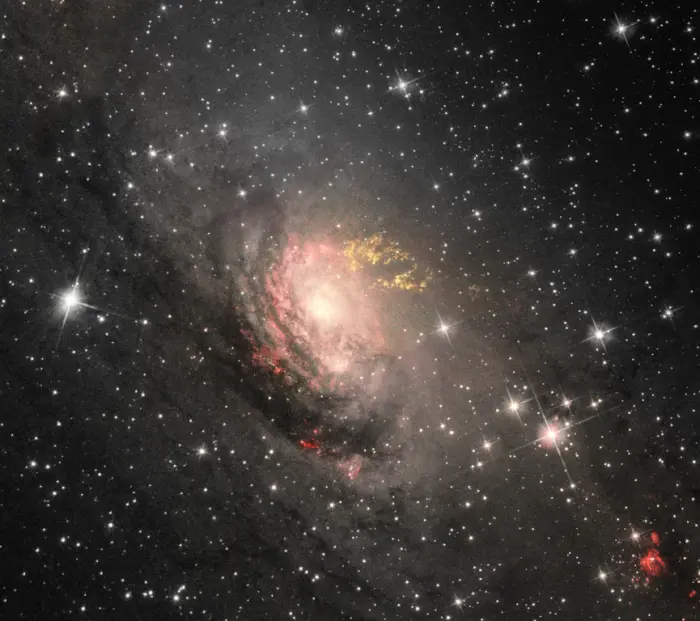
Circinus Galaxy, image credit: Judy Schmidt (CC BY 2.0)
The gas in the galaxy’s disk is concentrated in two rings. Both rings contain large amounts of gas and dust and are home to large starburst regions. These areas of starburst activity produce new stars on timescales of 40 – 150 million years.
The larger ring of the Circinus Galaxy spans 1,300 light-years in diameter. It is in the plane of the galaxy’s disk and was previously seen by ground-based telescopes. The smaller ring is 260 light-years across and was discovered by the Hubble Space Telescope (HST).
The Seyfert nucleus lies at the centre of the two starburst rings. The supermassive black hole and its accretion disk are ejecting gas from the disk into the galactic halo. The disk of material contains a lot of dust and gas that is slowly infalling into the central black hole. The gas in the inner ring is heated by ultraviolet radiation from the black hole and it glows in ultraviolet and X-ray wavelengths.
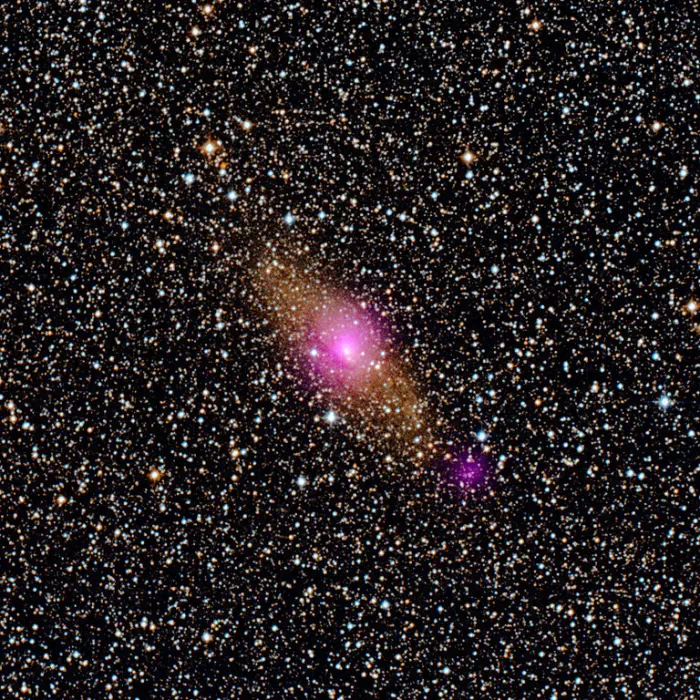
The magenta spots in this image show two black holes in the Circinus Galaxy: the supermassive black hole at its heart, and a smaller one closer to the edge that belongs to a class called ultraluminous X-ray sources, or ULXs. The magenta X-ray data come from NASA’s Nuclear Spectroscopic Telescopic Array, and are overlaid on a visible/infrared image from the Digitized Sky Survey. ULXs consist of black holes actively accreting, or feeding, off material drawn in from a partner star. Astronomers are trying to figure out why ULXs shine so brightly with X-rays. The ULX was spotted serendipitously by NuSTAR, which sees high-energy X-ray light. Further observations with other telescopes, combined with NuSTAR’s data, revealed that the black hole is about 100 times the mass of our sun. Image credit: NASA/JPL-Caltech
Facts
The Circinus Galaxy is one of the nearest major galaxies to the Milky Way. It is a member of the “Council of Giants,” a group of 12 large galaxies that surround the Local Group in the Local Sheet. The Local Group is the group of galaxies that includes the Milky Way, and the Local Sheet is the extragalactic region of space where our galaxy, the Andromeda Galaxy, the Triangulum Galaxy, and other members of the Local Group share a similar peculiar velocity. The region lies within a radius of 23 million light-years and, like the Local Group, it is part of the Virgo Supercluster.
The 12 galaxies in the Council of Giants surround the Milky Way in a radius of 12.2 million light-years. They also include Centaurus A and NGC 4945 (Caldwell 83) in the constellation Centaurus, the Hidden Galaxy (IC 342, Caldwell 5) in Camelopardalis, the Sculptor Galaxy (NGC 253, Caldwell 65) in Sculptor, Bode’s Galaxy and the Cigar Galaxy (Messier 81 and Messier 82) in Ursa Major, the Cat’s Eye Galaxy (Messier 94) in Canes Venatici, the Black Eye Galaxy (Messier 64) in Coma Berenices, the Southern Pinwheel Galaxy (Messier 83) in Hydra, and Maffei 1 and Maffei 2 in Cassiopeia.
Even though it is relatively bright and large, the Circinus Galaxy was only discovered in 1977. It was first observed by Freeman et al. on optical plates. The galaxy lies 4 degrees below the Galactic plane and is obscured by intervening dust. The galaxy’s two extended spiral arms were only detected during observations with NASA’s Wide-field Infrared Survey Explorer (WISE) and the Spitzer Space Telescope in infrared wavelengths.
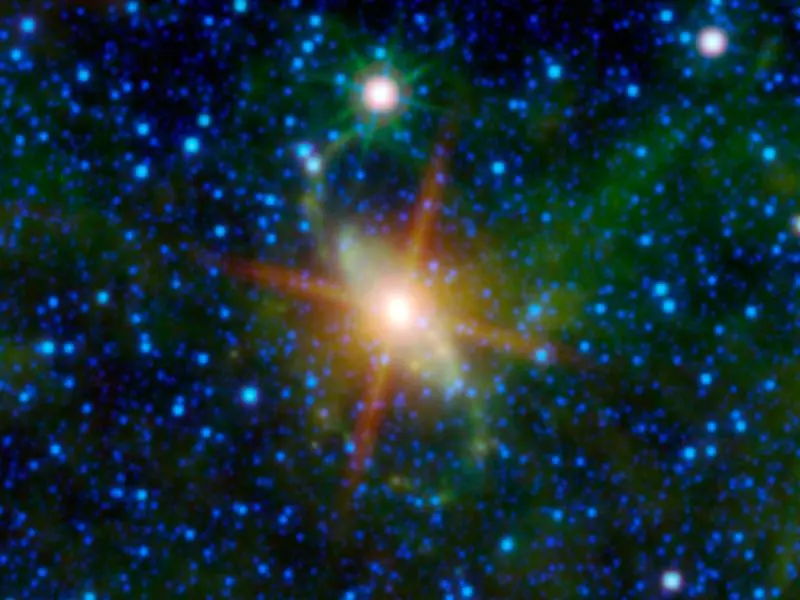
There’s something special going on in the nearby Circinus Galaxy, as revealed by this image from NASA’s Wide-field Infrared Survey Explorer, or WISE. The Circinus Galaxy is located in the constellation of Circinus and is obscured by the plane of our Milky Way galaxy. At a distance of 14 million light-years, it is one of the nearest galaxies, yet is largely unexplored because the Milky Way veils it. There are so many stars and so much dust from our own galaxy obscuring the Circinus Galaxy. In fact, this galaxy has two extended spiral arms, which look like a great green “S” in this WISE image. These arms had not been seen until NASA’s Spitzer Space Telescope and WISE observed them. The infrared wavelengths of light detected by these observatories pierce through the foreground dust of the Milky Way, revealing aspects of the special nature of the Circinus Galaxy. Image credit: NASA/JPL-Caltech/UCLA
The Circinus Galaxy was imaged by the Hubble Space Telescope (HST) on April 10, 1999. Hubble revealed the galaxy’s two rings and the prominent streamers of gas expelled by the black hole. The data obtained by Hubble in visible light and in the near-infrared band has provided astronomers with insights into the dynamics of active galaxies like ESO 97-G13.
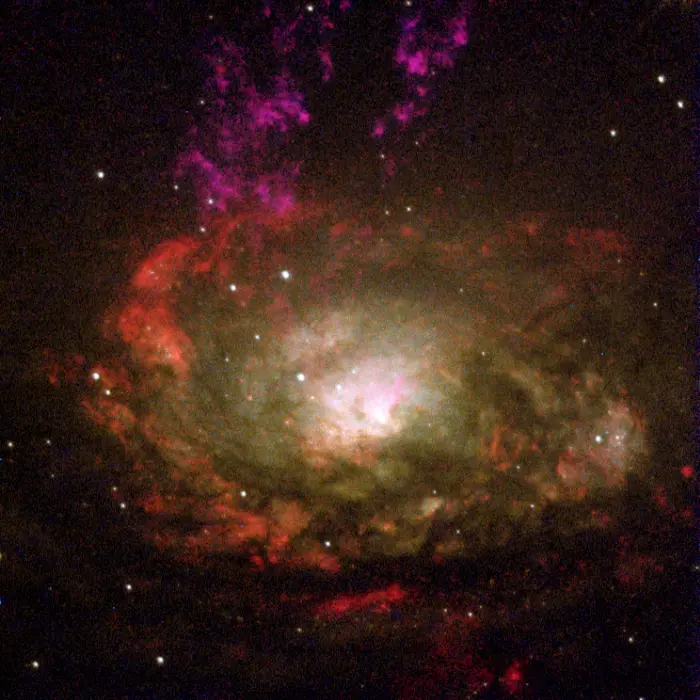
Resembling a swirling witch’s cauldron of glowing vapors, the black hole-powered core of a nearby active galaxy appears in this colorful NASA Hubble Space Telescope image. This galaxy is designated a type 2 Seyfert, a class of mostly spiral galaxies that have compact centers and are believed to contain massive black holes. Seyfert galaxies are themselves part of a larger class of objects called Active Galactic Nuclei or AGN. AGN have the ability to remove gas from the centers of their galaxies by blowing it out into space at phenomenal speeds. Astronomers studying the Circinus Galaxy are seeing evidence of a powerful AGN at the center of this galaxy as well. In the center of the galaxy and within the inner starburst ring is a V-shaped structure of gas. The structure appears whitish-pink in this composite image, made up of four filters. Two filters capture the narrow lines from atomic transitions in oxygen and hydrogen; two wider filters detect green and near-infrared light. In the narrow-band filters, the V-shaped structure is very pronounced. This region, which is the projection of a three-dimensional cone extending from the nucleus to the galaxy’s halo, contains gas that has been heated by radiation emitted by the accreting black hole. A “counter-cone,” believed to be present, is obscured from view by dust in the galaxy’s disk. Ultraviolet radiation emerging from the central source excites nearby gas causing it to glow. The excited gas is beamed into the oppositely directed cones like two giant searchlights. Image credit: NASA, Andrew S. Wilson (University of Maryland); Patrick L. Shopbell (Caltech); Chris Simpson (Subaru Telescope); Thaisa Storchi-Bergmann and F. K. B. Barbosa (UFRGS, Brazil); and Martin J. Ward (University of Leicester, U.K.)
The galaxy hosted a supernova, SN 1996cr, which was first detected only in 2001, when it appeared as a bright, variable object about 23 arcseconds south of the galaxy in an image taken by NASA’s Chandra X-ray observatory. The object was not identified as a supernova until much later. It was classified as a type IIn supernova. This type of supernova is believed to be produced by exceptionally massive stars similar to luminous blue variables, which undergo enormous mass loss before going out as supernovae.
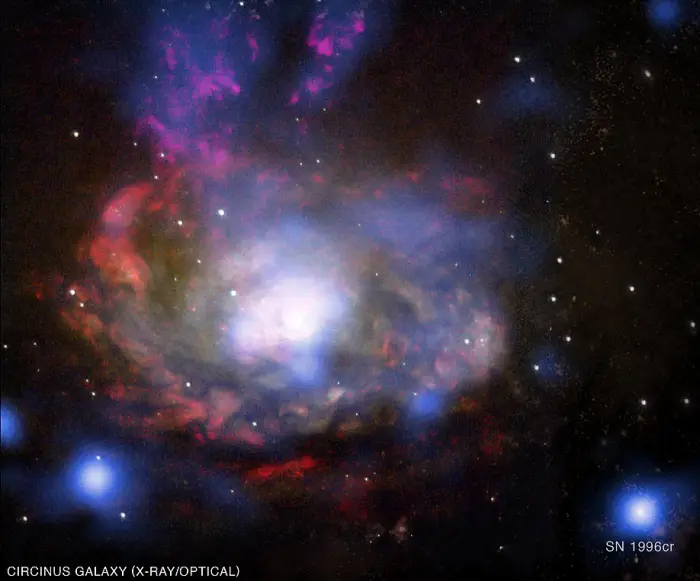
This composite image shows the central regions of the nearby Circinus Galaxy. Data from NASA’s Chandra X-ray Observatory is shown in blue and data from the Hubble Space Telescope is shown in yellow (“I-band”), red (hydrogen emission), cyan (“V-band”) and light blue (oxygen emission). The blue source near the lower right hand corner of the image is the supernova SN 1996cr, that has finally been identified over a decade after it exploded. The supernova was first singled out in 2001 as a bright, variable object in a Chandra image, but it was not confirmed as a supernova until years later, using data from a total of 18 different telescopes, nearly all of which was from archives. Image credit: Chandra X-ray Observatory, Smithsonian Institution; X-ray (NASA/CXC/Columbia/F.Bauer
A 2016 study reported the discovery of a possible companion for the Circinus Galaxy. The smaller galaxy is catalogued as HIZOA J1353-58 and lies in the Zone of Avoidance (ZOA), the area veiled by the Milky Way. It appears less than 8 degrees from the Circinus Galaxy and has a similar recessional velocity to the larger galaxy. The companion was detected during a survey of neutral hydrogen in the extragalactic sky with the 64-metre Parkes radio telescope.
A study published in 2022 mapped the globular clusters in the Circinus Galaxy based on deep near-infrared photometry by the VISTA Variables in the Via Láctea Extended Survey (VVVX) and astrometric data obtained from Gaia Early Data Release 3 (Gaia EDR3). The VISTA survey focused on observing the Milky Way’s bulge and southern disk using the VISTA Telescope at the Paranal Observatory in Chile. The study identified a population of about 70 globular clusters in the galaxy.
Location
The Circinus Galaxy appears southwest of Alpha Circini, in the direction of Acrux, the star at the base of the Southern Cross. The bright stars of Centaurus and Triangulum Australe can be used for orientation.
Alpha Circini shines at magnitude 3.18 and does not really stand out in the sky. It forms an elongated triangle with the fainter Beta and Gamma Circini. The triangle appears between the brighter Southern Triangle (Triangulum Australe) and the Southern Pointers, Alpha and Beta Centauri (Rigil Kentaurus and Hadar). Alpha Circini lies about a third of the way from Beta Trianguli Australis to Acrux, in the region between Hadar and Gamma Trianguli Australis.
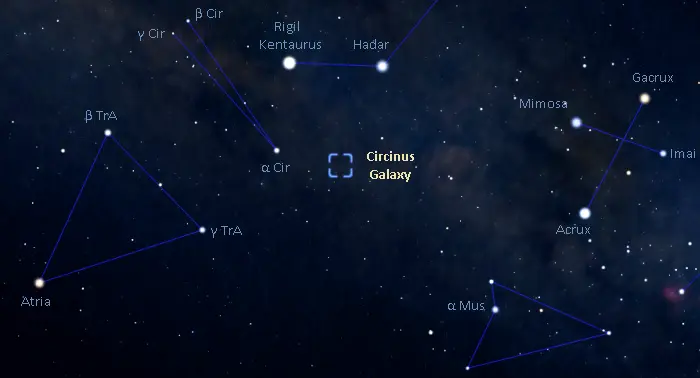
The location of the Circinus Galaxy, image: Stellarium
At declination -65°20’, the Circinus Galaxy never rises for observers north of the latitude 24° N, and it never appears very high above the horizon for northern observers in equatorial latitudes.
The galaxy appears in a very rich star field. Small telescopes will reveal a faint patch about 2 by 1 arcseconds across. Larger instruments will show a faint extended halo. Long-exposure photographs show the dark lane on the galaxy’s central bulge, reminiscent of the better-known Black Eye Galaxy (Messier 64) in Coma Berenices.
The best time of the year to observe the Circinus Galaxy is during the month of July, when the constellation Circinus appears higher above the horizon in the evening.
Circinus Galaxy – ESO 97-G13
| Constellation | Circinus |
| Type | SA(s)b |
| Right ascension | 14h 13m 09.906s |
| Declination | −65° 20′ 20.47″ |
| Apparent magnitude | 12.1 |
| Apparent size | 6′.9 × 3′.0 |
| Distance | 13 million light-years (4.0 megaparsecs) |
| Redshift | 426 ± 25 km/s |
| Names and designations | Circinus Galaxy, ESO 97-G13, LEDA 50779 |